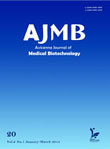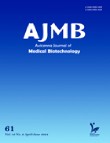فهرست مطالب

Avicenna Journal of Medical Biotechnology
Volume:5 Issue: 4, Oct-Dec 2013
- تاریخ انتشار: 1392/07/23
- تعداد عناوین: 9
-
-
Page 203
-
Page 204BackgroundStaphylococcus aureus (S. aureus) is a major nosocomial pathogen and the infection with this organism in human is increasing due to the spread of antibiotic resistant strains. One of the resistance mechanisms of S. aureus comprises modification in binding proteins to penicillin. Vaccine strategy may be useful in controlling the infections induced by this organism. This study aimed at developing and producing the recombinant protein PBP2a as a vaccine candidate and evaluating the related humoral immune response in a murine model.MethodsA 242 bp fragment of mecA gene was amplified by PCR from S. aureus COL strain and then cloned into prokaryotic expression vector pET-24a. For expression of recombinant protein, pET24a-mec plasmid was transformed into competent E. coli BL21 (DE3) cells. Recombinant protein was over expressed with 1 mM isopropythio-β-D-galctoside (IPTG) and purified using Ni-NTA agarose. SDS-PAGE and western blotting were carried out to confirm protein expression. For immunization of experimental groups, Balb/c mice were injected subcutaneously with 20 µg of recombinant PBP2a three times with three weeks intervals. The sera of experimental groups were collected three weeks after the last immunization and then specific antibodies were evaluated by ELISA method.ResultsSuccessful cloning of mecA was confirmed by colony-PCR, enzymatic digestion, and sequencing. SDS-PAGE and western blot analysis showed that recombinant protein with molecular weight of 13 kDa is over expressed. In addition, high titer of specific antibody against PBP2a in vaccinated mice was developed as compared with the control group and confirmed the immunogenicity of the vaccine candidate.ConclusionResults suggest that PBP2a recombinant induced specific antibodies and can be used as Staphylococcal vaccine candidate after further studies.Keywords: Methicillin, resistant Staphylococcus aureus, PBP2a, Recombinant vaccine
-
Page 212BackgroundFerritin is an iron storage protein, which plays a key role in iron metabolism. Measurement of ferritin level in serum is one of the most useful indicators of iron status and also a sensitive measurement of iron deficiency. Monoclonal antibodies may be useful as a tool in various aspects of ferritin investigations. In this paper, the production of a murine monoclonal antibody (mAb) against human ferritin was reported.MethodsBalb/c mice were immunized with purified human ferritin and splenocytes of hyper immunized mice were fused with Sp2/0 myeloma cells. After four times of cloning by limiting dilution, a positive hybridoma (clone: 2F9-C9) was selected by ELISA using human ferritin. Anti-ferritin mAb was purified from culture supernatants by affinity chromatography.ResultsDetermination of the antibody affinity for ferritin by ELISA revealed a relatively high affinity (2.34×109 M-1) and the isotype was determined to be IgG2a. The anti-ferritin mAb 2F9-C9 reacted with 79.4% of Hela cells in flow cytometry. The antibody detected a band of 20 kDa in K562 cells, murine and human liver lysates, purified ferritin in Western blot and also ferritin in human serum.ConclusionThis mAb can specifically recognize ferritin and may serve as a component of ferritin diagnostic kit if other requirements of the kit are met.Keywords: ELISA, Ferritin, Flow cytometry, Monoclonal antibody, Western blotting
-
Page 220BackgroundLight chain (LC) and heavy chain carboxyterminal subdomain (HCC) fragments are the most important parts of tetanus neurotoxin (TeNT) which play key roles in toxicity and binding of TeNT, respectively. In the present study, these two fragments were cloned and expressed in a prokaryotic system and their identity was confirmed using anti-TeNT specific polyclonal and monoclonal antibodies.MethodsLC and HCC gene segments were amplified from Clostridium tetani genomic DNA by PCR, cloned into pET28b(+) cloning vector and transformed in Escherichia coli (E. coli) BL21(DE3) expression host. Recombinant proteins were then purified through His-tag using Nickel-based chromatography and characterized by SDS-PAGE, Western blotting and ELISA techniques.ResultsRecombinant light chain and HCC fragments were successfully cloned and expressed in (E. coli) BL21 (DE3). Optimization of the induction protocol resulted in production of high levels of HCC (~35% of total bacterial protein) and to lesser extends of LC (~5%). Reactivity of the His-tag purified proteins with specific polyclonal and monoclonal antibodies confirmed their renatured structure and identity.ConclusionOur results indicate successful cloning and production of recombinant LC and HCC fragments of TeNT. These two recombinant proteins are potentially useful tools for screening and monitoring of anti-TeNT antibody response and vaccine production.Keywords: Fragment C, Light chain, Monoclonal antibody, Tetanus toxin
-
Page 227BackgroundToxoplasmosis is a worldwide-distributed infection which is mostly asymptomatic but can cause serious health problems in congenitally-infected newborns and immunecompromised individuals. Research is undergoing both to improve Toxoplasma serological tests, which play the main role in laboratory diagnosis of the infection, and develop an effective vaccine to prevent the infection. Some studies showed usefulness of rhoptry protein 1 (ROP1) antigen of Toxoplasma gondii (T. gondii) in serodiagnosis of the infection and induction of protective immunity. The purpose of this study was to produce recombinant ROP1 and evaluate its antigenicity against human infected sera.MethodsDNA encoding ROP1, amino acids 171 to 574, was obtained from T. gondii RH strain by polymerase chain reaction amplification and cloned in prokaryotic expression plasmid pET-15b. rROP1 was expressed in Escherichia coli (E. coli) and purified in a single step by immobilized metal ion affinity chromatography.ResultsDNA sequencing showed 99% similarity between the cloned sequence and the corresponding sequence in Gene bank. Results indicated the proper antigenicity of rROP1. Sera from Toxoplasma infected individuals specifically recognized rROP1 in Western blotting.ConclusionrROP1 is antigenic toward human infected sera and can be used in studies for development of both a Toxoplasma serological test and a protective vaccine.Keywords: Gene expression, Purification, ROP1 protein, Toxoplasma gondii
-
Page 234BackgroundMicropatterning is becoming a powerful tool for studying cells in vitro. This method not only uses very small amount of material but also mimic the microenvironment structure present in living tissues better than flask culturing techniques. In previous studies using micropatterning of extracellular matrix proteins on glass surfaces, the rate of protein detachment from the surface was so high that the proteins and the cultivated cells detached after 3 three days of cell seeding.MethodsHere we optimized the glass surface modification method to fulfill the requirement of most in vitro studies.Resultsin our study we showed that the optimum time for glass surface modification reaction is 1.5 hr, and the cells could be tracked in vitro for over 15 days after cell seeding which is enough for the most in vitro studies. As a model, we cultivated HEK 293T and HepG2 cells on the collagen micropatterns and showed that they have normal growth and morphology on these micropatterns. The HEK cells also transfected with pmaxGFP plasmid vector to show that the cells on collagen micropatterns could also used in transfection studies.ConclusionTaking these together, this novel method is promising for efficient cell culture studies on micropatterened surfaces in the future.Keywords: Cellular microenvironment, Collagen type I, Tissue engineering
-
Page 241BackgroundThe microarray technology is in needed of cost-effective, low background noise and stable substrates for successful hybridization and analysis.MethodsIn this research, we developed a three-dimentional stable and mechanically reliable microarray substrates by coating of two polymeric layers on standard microscope glass slides. For fabrication of these substrates, a thin film of oxidized agarose was prepared on the Poly-L-Lysine (PLL) coated glass slides. Unmodified oligonucleotide probes were spotted and immobilized on these double layered thin films by adsorption on the porous structure of the agarose film. Some of the aldehyde groups of the activated agarose linked covalently to PLL amine groups; on the other side, they bound to amino groups of adsorbed tail of biomolecules. These linkages were fixed by UV irradiation at 254 nm using a CL-1000 UV. These prepared substrates were compared to only agarose-coated and PLL-coated slides.ResultsAtomic Force Microscope (AFM) results demonstrated that agarose provided three-dimensional surface which had higher loading and bindig capacity for biomolecules than PLL-coated surface which had two-dimensional surface. The nano-indentation tests demonstrated the prepared double coating was more reliable and flexible for mechanical robotic spotting. In addition, the repeated indentation on different substrates showed uniformity of coatings. The stability of novel coating was sufficient for hybridization process. The signal-to-noise ratio in hybridization reactions performed on the agarose-PLL coated substrates increased two fold and four fold compared to agarose and PLL coated substrates, respectively.ConclusionFinally, the agarose-PLL microarrays had the highest signal (2920) and lowest background signal (205) in hybridization, suggesting that the prepared slides are suitable in analyzing wide concentration range of analytes.Keywords: Agarose, Microarray analysis, PLL, Signal, to, noise ratio
-
Page 251BackgroundFamilial Idiopathic Basal Ganglia Calcification (IBGC) is a rare neurodegenerative disorder which is usually transmitted as an autosomal dominant trait. IBGC is genetically heterogeneous and SLC20A2, on chromosome 8p21.1–8q11.23, is the first gene found in IBGC-affected patients with varied ancestry. On the other hand, several candidate genes for IBGC on chromosome 2q37, including the SPP2 gene, may play a role in inhibiting calcification.MethodsTotally, 22 members of a three generational Iranian family affected by IBGC, with an autosomal dominant pattern of inheritance were included in this study. DNA was extracted from the whole blood using standard salting out method. To find a mutation responsible for IBGC, we sequenced the coding region of SLC20A2 as well as promoter and coding region of SPP2 in the index subject of IBGC-affected family.ResultsPathogenic mutation was found neither in SLC20A2 nor in SPP2.ConclusionOur results strengthen genetic heterogeneity of this condition. Additional mutation studies are necessary to find a gene or genes responsible for IBGC in this affected family.Keywords: Familial Idiopathic Basal Ganglia Calcification, Mutation, SLC20A2 protein, SPP2 protein


